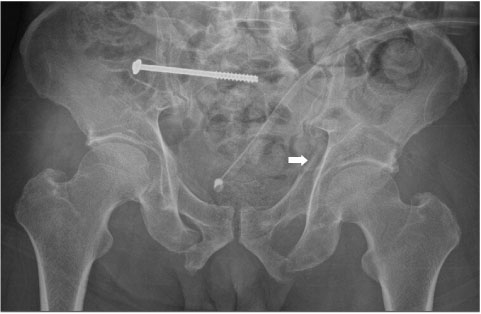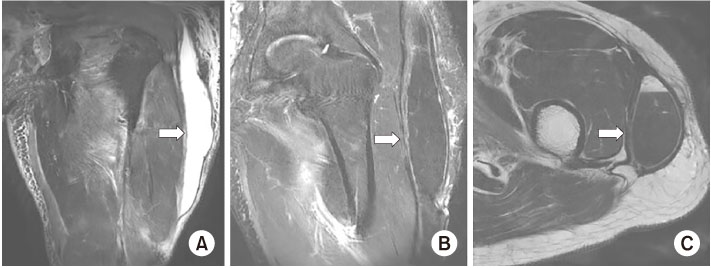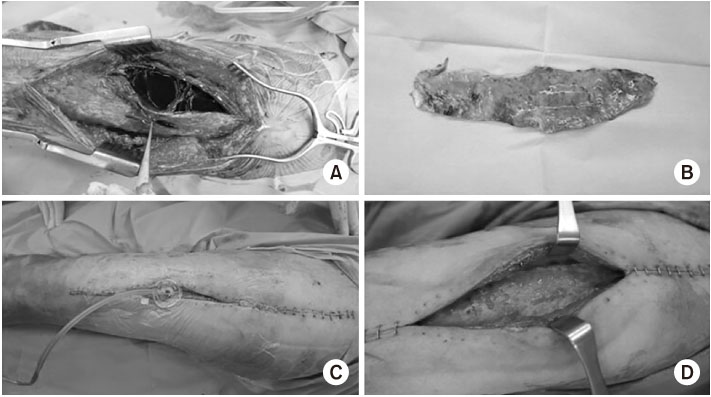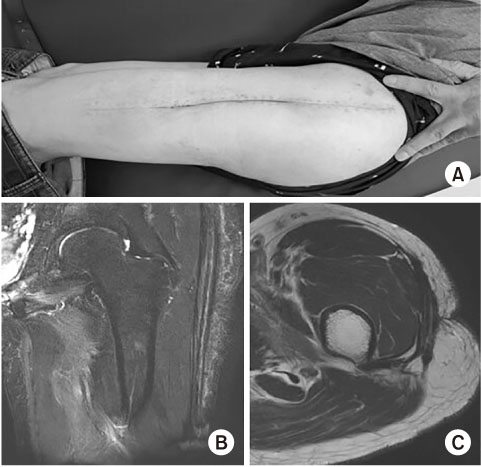Articles
- Page Path
- HOME > J Musculoskelet Trauma > Volume 33(4); 2020 > Article
- Case Report Sclerotherapy Using Abnobaviscum for the Extensive Recurrent Chronic Morel-Lavallée Lesions - A Case Report -
- Joon-Kuk Kim, Ji-Won Jung, Ki-Chul Park
-
Journal of Musculoskeletal Trauma 2020;33(4):222-226.
DOI: https://doi.org/10.12671/jkfs.2020.33.4.222
Published online: October 31, 2020
- 476 Views
- 7 Download
- 1 Crossref
- 0 Scopus
Abstract
The Morel-Lavallée lesion (MLL) is a closed soft-tissue degloving injury, resulting in characteristic hemo-lymphatic fluid collection between the fascia and subcutaneous layers. The MLL was managed routinely with drainage and compression bandages, but sclerotherapy can be used in patients with chronic lesions refractory to first-line therapy. This paper presents a case of extensive recurrent chronic MLL treated with sclerotherapy using Abnobaviscum, which has been used to treat adhesion in malignant pleural effusion.
Published online Oct 22, 2020.
https://doi.org/10.12671/jkfs.2020.33.4.222
Sclerotherapy Using Abnobaviscum for the Extensive Recurrent Chronic Morel-Lavallée Lesions: A Case Report
Abstract
The Morel-Lavallée lesion (MLL) is a closed soft-tissue degloving injury, resulting in characteristic hemolymphatic fluid collection between the fascia and subcutaneous layers. The MLL was managed routinely with drainage and compression bandages, but sclerotherapy can be used in patients with chronic lesions refractory to first-line therapy. This paper presents a case of extensive recurrent chronic MLL treated with sclerotherapy using Abnobaviscum, which has been used to treat adhesion in malignant pleural effusion.
Fig. 1
Immediate postoperative radiograph shows the stabilization of a pelvic ring injury, including left acetabular fracture (arrow).
Fig. 2
(A) Magnetic resonance image shows fluid collection (28 cm×5 cm×2 cm; arrow) between the fascia and the subcutaneous layer on postoperative one month. (B, C) After eight months of conservative treatment, magnetic resonance was repeated, showing persistent fluid collection (32 cm×3 cm×6 cm; arrows) with thick enhancing fibrous capsulation.
Fig. 3
(A) Intraoperative appearance of Morel-Lavallée lesion at the left thigh. (B) It was surrounded by thick fibrous capsulation and excised during debridement. (C) The vacuum-assisted closure system was applied to the wound after secondary debridement. (D) After repeated debridement and change in the vacuum-assisted closure system for one week, Abnobaviscum (Abnoba Korea) was administered as a sclerosing agent on an open wound.
Fig. 4
(A) Gross photography of the left thigh. Improved swelling and fluctuation after sclerotherapy. (B, C) After two months of sclerotherapy, a resolved Morel-Lavallée lesion was observed by magnetic resonance imaging.
Financial support:None.
Conflict of interests:None.

 E-submission
E-submission KOTA
KOTA TOTA
TOTA TOTS
TOTS






 Cite
Cite

